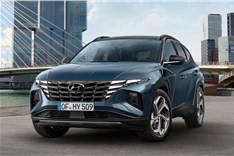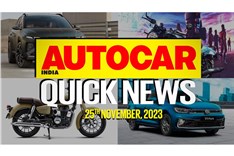2016 Hyundai Tucson India review, test drive
The Tucson is back, and fills the gap between the Creta and the Santa Fe. We drive it around Chandigarh to bring you this review.
Published on Nov 17, 2016 03:55:00 PM
59,683 Views
Follow us on



What’s it like on the inside?
On the inside, the Tucson looks more Creta than Santa Fe. The Creta’s cabin is a good place to begin with but upgraders will expect something more and distinct. There is a two-tone black and beige dash with a distinct separation between the dual zone HVAC and the entertainment unit. Speaking of which is an 8-inch touchscreen like the one in the Elantra, with both Android Auto and Apple CarPlay. Thankfully, there are also knobs and dials for a few of the functions. The dials are crisp to read and have a 4.2-inch colour screen between them for trip computer and other info. Below the HVAC are two power sockets and one USB slot, but in today's connected times, it should have been the other way around. Interestingly, the higher-spec car gets a slightly different centre console floorpan with an extra cubby hole and a larger central console box. The multi-function steering wheel is leather-wrapped as are the seats, armrests and transmission knob.
Interior space is generous and the legroom at the rear is very impressive. Furthermore the rear seat backs also recline, the only thing is that the rear seats are set quite low and thus with window line higher than usual your view outside is slightly reduced. The boot is large with 513 litres of storage. It can be accessed with the auto-opening feature ala Elantra, where it pops open if you stand near with the key on you. But just like the Elantra we had trouble getting this to work all the time. The boot can be extended with a 60:40 split rear seat.
The all-automatic cars have six airbags, with the manual one getting just two. ABS with EBD are standard and the top trim gets electronic stability control, hill start and brake assist along with downhill brake control. Parking sensors are present for the front and rear, along with a rear camera view.
What’s it like to drive?
Hyundai offers the Tucson with a choice of a petrol and a diesel, and both can be paired with a six-speed automatic or manual transmission. We drove the auto boxes of both engines. The petrol is the same 2.0-litre unit from the Elantra and makes 155hp at 6200 rpm and 192Nm of torque. While on the Elantra this engine feels very alive, on the Tucson the extra weight blunts the edge considerably. It's fine for daily driving, but you find the gearbox downshifting often in a bid to keep up performance. Even in Sport mode or with manual changes, the car's performance isn’t all that lively and sound levels do get high with the engine always sounding more enthusiastic than the performance it is delivering.
Copyright (c) Autocar India. All rights reserved.







Comments
Member Login
Personal Details
No comments yet. Be the first to comment.